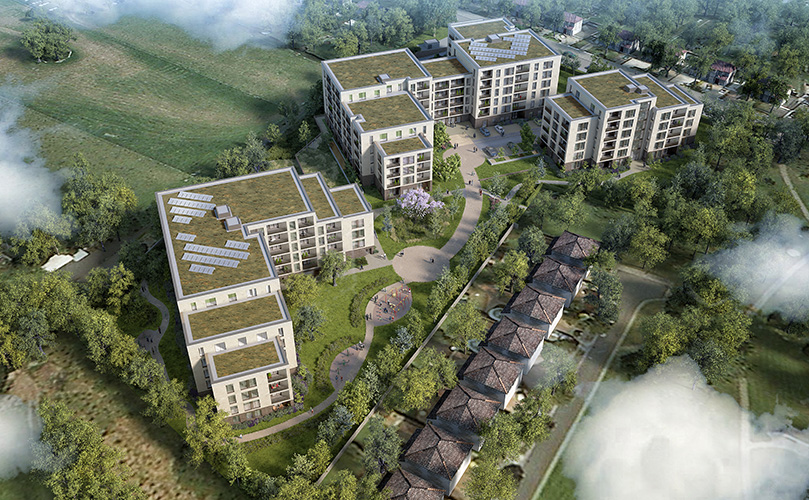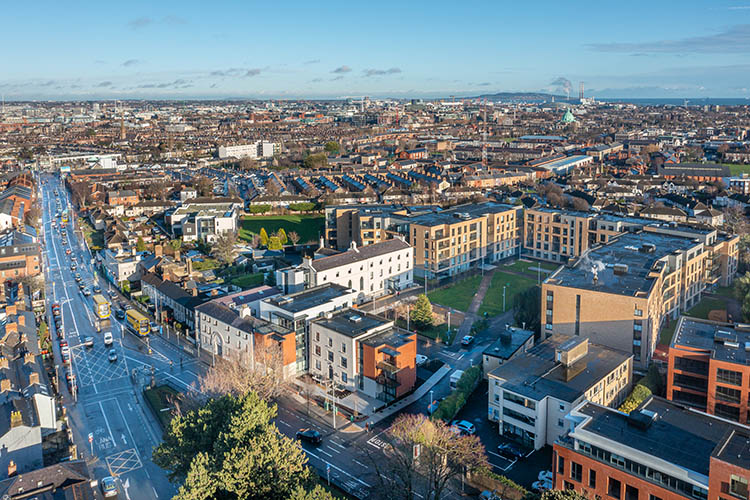Sakinah Brennan, Head of ESG, Marlet Property Group, speaks with ROBBIE COUSINS about how the leading real estate group is reducing carbon emissions across its operations and property portfolio and why there is much more to sustainability than constructing A-rated buildings.
Under its sustainability policy, Pat Crean’s Marlet Property Group describes itself as being committed ‘to building thriving communities by creating healthy, sustainable places to live’. This, it says, is at the core of everything it does, and as one of Ireland’s largest property developers, it sees itself as having ’a responsibility to lead the industry in sustainable practices by setting measurable targets, reporting on progress, and driving innovation throughout its developments’.
Sustainability awareness
Marlet’s head of ESG, Sakinah Brennan, says she has observed huge growth in the level of knowledge and understanding across the industry about sustainability and the development of healthy buildings for people to live and work in.
“Time was when a developer would deliver an A2- or A3-rated building, and everyone was happy,” Sakinah Brennan comments. “There were no questions about the carbon emissions from delivering that building or the carbon emitted in operating the building in two or three years. But, because of the work by bodies such as the Irish Green Building Council (IGBC), there is now a growing appreciation and understanding of the critical importance of reducing the embodied carbon of the buildings we construct and that they should also perform in carbon terms as one would expect an A-rated building to perform.”
As head of ESG with Marlet, her job is not just about sustainability – although this is a huge chunk of her responsibility – Brennan also oversees initiatives around the social impact of Marlet projects as well as the governance and reporting aspect of the property developer’s business.
“The emergence of ESG has been a real game changer for the property development business,” she continues. “It has enabled companies to set out a structured route to contribute to reducing carbon emissions and help create a better society through targeted and measurable actions. For Marlet, this has been driven and supported by our head of development Brian Coppinger.
“For the most part, my role is taken up with the classic kind of environmental sustainability, making sure that Marlet schemes are future-proofed and that we use the best technologies and processes available to build in a sustainable way.”
Social impacts
The social side of the role has become more central to what Marlet does.
“Marlet is a large-scale residential developer, predominantly operating in and around Dublin city, and what we do impacts established communities. So, we aim to build developments that, in addition to being healthy, sustainable places for our tenants, add social value to surrounding communities.
“To this end, we engage with local communities and provide spaces in our developments that can be used for wider community gain. This could be in the form of meeting halls, or even arts or community programmes and exhibitions organised in conjunction with local authorities and local community groups.”
The governance piece, she says, is about ensuring that what Marlet does is clear and transparent to all stakeholders.
One example of a Marlet initiative that ticks all of these boxes is a blue roof being installed on its Green Acre Grange build-to-rent (BTR) development in Dundrum, Dublin.
“In our Green Acre Grange development, we are developing one of the country’s first blue roofs, which is a very exciting sustainable piece of infrastructure that will benefit the wider community. It is designed to provide temporary storage and slow release of stormwater runoff. So, not only are we driving sustainability with innovation in a very large residential scheme, we are mitigating flooding for the local community, and we are able to report to investors and the local authority that the initiative will have a huge positive social impact.”
Brennan adds that the BTR model requires developers to focus on community building and to make sure that they are building places where people want to live.
#BuildingLife campaign
Marlet has worked with the IGBC for several years, and it enjoys a synergic relationship with the body.
“The #BuildingLife campaign reflects one of our biggest challenges,” Sakinah Brennan explains. “For Marlet, much of our focus is on reducing scope 3 category GHG emissions. These emissions result from activities in assets we own and manage. Because we are a developer of BTR schemes, this includes the embodied carbon of the buildings we construct, as well as the operational emissions of the buildings. “The #BuildingLife campaign is the first programme that recognises this challenge. It is pushing the industry, suppliers and regulatory bodies to acknowledge and address where carbon starts and ends when it comes to construction and building performance.
“The leadership that the IGBC has shown in working with people across the industry to develop the Building a Zero Carbon Ireland roadmap to decarbonise Ireland’s construction and built environment sector has resulted in a massive change in the sector. The industry is finally transitioning to a point where we are beginning to measure the impacts of buildings, not just during operation but the whole process of how they come into being.
“It is invaluable to us as a developer to have this outlook whereby we measure carbon from the raw materials for the very first brick come out of the ground right through to the building’s end of life and disposal. This is why IGBC’s work aligns perfectly with the challenges we are looking to address.
Brennan adds that before #BuildingLife, the embodied carbon piece was not something that anybody put any pressure on developers to address.
“People wanted a shiny new building with an A BER rating. There was little or no concern about it having very low operating emissions or about how it was built to achieve an A1 or A2 rating. The campaign has put emissions reductions out front, and it makes people aware of the fact that if we are serious about reducing the carbon footprint of the sector, we must take a wholistic approach.
“But, it is still early days, and while there are huge roadblocks to be addressed, the campaign has brought focus to the challenges ahead.”
Sustainability at Marlet
Marlet now carries out carbon assessments from the beginning of each development.
“We carry out carbon assessments on our early designs, Sakinah Brennan explains. “This tells where we are with any project in terms of our carbon intensity and enables us to make construction method, design and specification changes to reduce that intensity. Small design or materials specification changes can result in massive carbon emission reductions. Considering carbon at the beginning of a project rather than further down the road is a huge game changer. We have made good use of the IGBC life cycle assessment tools, such as its carbon calculator, to this end.”
Environmental Product Declarations
Marlet has introduced a requirement for environmental product declarations (EPDs) into its procurement process.
“In all of our contracts, we have a requirement for a minimum number of product EPDs to be met. This is essential,” Brennan explains. “If we are to progress carbon reduction in construction, EPDs for all products must be brought on-stream. One of the biggest challenges in preparing carbon figures during assessments is the huge level of approximation we still carry out. We need better data to make more specific, informed choices on what products we are using. We have seen substantial advances in the production of EPDs in the past 12 months. Supplier knowledge has improved. It is easier for larger manufacturers to produce EPDs. But many small- and medium-sized producers need more support to develop this essential side of their business. Enterprise Ireland has been very good, but there needs to be more push to encourage and support firms to produce EPDs.”
Sakinah Brennan says that while the science is moving, it is not happening quickly enough.
“Sustainable solutions are not being made available in the cost-efficient way for us to make the huge impact decisions that we want. I think greater innovation in certain critical building materials is needed, and the government needs to assist with this, maybe through grants and new regulations.
“Setting carbon emission reduction targets, which is what everyone is talking about, is really important. But, if the science doesn’t catch up and we don’t put these key enablers in place, the targets will become defunct. The 2030 51% carbon emissions reduction target set for the sector will not be achievable.”
Sustainable renovation
In terms of sustainable development opportunities, one area that excites Sakinah Brennan is the move towards renovation, especially in the commercial building space in city centres.
“In the past, the norm was to demolish and then build a more efficient building. But we now appreciate that there’s substantial carbon in existing buildings, and the far more environmentally-friendly route is to refurbish them. Marlet sees great opportunities in this area.”
She adds that biodiversity in buildings is also finally being taken more seriously.
“Marlet is moving towards taking a biodiversity net-gain approach on our schemes, even bringing biodiversity into our buildings. This is great for the environment and for the people who live and work in these buildings.
“We now measure the biodiversity of a site at the very beginning of a project before design. We then design in added diversity, so we not only maintain what we can of what is there but add to it. This is new, but it is being incorporated into all of our early scheme designs.
“And, of course, we provide full reports to investors, local authorities and planners, all of whom have responded positively to this. Stakeholders want us to be innovative and to go the extra mile, and our challenge is to work this within the budget of the project.”
Reducing operational emissions
Marlet is introducing initiatives to make sustainability improvements in its BTR schemes. Initiatives undertaken include retrofitting filtered water taps to provide drinking water in individual residential units. It has also had great success with introducing more sustainable waste disposal practices.
“In a survey of residents in our St Clare’s Park, Harold’s Cross BTR scheme,” Sakinah Brennan explains, “We learned that residents were very supportive of us working to reduce the environmental impact of the development. 75% of respondents said that they were ‘extremely interested’ in what we were doing to make where they lived more sustainable.
“Through work with Bord na Mona, we introduced waste compactors at St Clare’s, and this has reduced the number of waste collection journeys required by our waste disposal contractor.
“An initiative we are currently working on is to provide residents with monthly emissions performance reports on their buildings through an app so that they can see the carbon footprint of where they live. We aim to develop this and get to a point where in cooperation with residents, we set emissions reduction targets and work with them to hit these targets.”
In conclusion
In closing, she says that Marlet, going forward, has changed its energy procurement strategy to the complete electrification of buildings with smart metering for all tenants to enable them to collect as much data as possible in terms of use.
“When it comes to sustainability, we know where we are now. We have sustainable procurement policies in place. We know that our tenants support us in developing more sustainable buildings. We will continue to work with the IGBC and our supply chain to reduce embodied carbon of our developments. We know that there is much to be done if the sector as a whole is to achieve that 51% carbon emissions reduction goal by 2030, but Marlet is committed to being at the fore in helping the sector achieve this goal,” Sakinah Brennan concludes.






